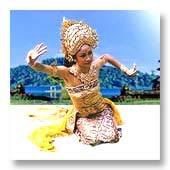Before we talk about a Balinese stage, let us take a glance on what Oxford Advance Learners Dictionary has to offer on the word ‘stage’ in the context of theater – a raised area, usually in theater, etc. where actors, dancers, etc. perform. When we apply this definition on what is called stage by the Balinese, it is clear that there are only few stages in Bali. But when we define the word “stage” as Balinese define it – place to perform a performance, everywhere is a stage in Bali. For wherever there is a space to dance, to mount a play, there is the Balinese stage.
A stage in Bali can be the hamlet meeting hall (bale banjar), the temple court, the ground outside the temple, the courtyard of Balinese house, the outer courtyard of a palace, sometimes it maybe the village street, the football or volleyball field. Sometimes its floor is bare earth, covered by with palm leaf mating; its roof is the sky or an overhanging tree or as a shelter from sun and rain, a ceiling of woven coconut leaves supported on the pillars of bamboo. The décor maybe the gateway of a palace or temple, or the flight of steps leading up to it, or if there is no gateway available a temporary décor made of bamboo and cloth in the form of a door will do just fine.
As there are only few stable theaters, most of the stage properties are portable ones. There is the curtain in Arja, Topeng and Jauk, there are lances and umbrellas of Barong play, Gambuh and Baris and a Calonarang performance has a male papaya-tree, which must always be planted on the dance ground, as a favorite place for the witch and her disciples to play.
The Balinese stage is static, the change of scene, for example in a drama performance do not involve the change of stage’s décor. The conversation of the characters alone indicates where they happen to be at the moment; in a forest, on the sea shore, in a market place, palace court, or grave yard or journeying from one place to another. Peasants tramping round the stage are always on their way to the rice fields, or possibly put their trouble before the king, a king or guards will probably denote a palace; witch transformation or the great witch Rangda herself indicates a graveyard; women with offerings sign at a temple.
The progress of a journey is suggested by words, glances and deviations over very restricted space of the dance-ground. Things are seen afar, they grew nearer and finally the illusion given arriving at a distant place, though the end is the same as the beginning. Demons or divinities followed on their course through the air. The décor of Balinese stage is in the mind of the spectators.
Balinese stage is just a place for performing the performance. The actual stage is in the mind of the spectators since no décor can surpass the beauty of human imagination. (BALIwww)












